Between June 24 and July 13, no fewer than three carcasses of endangered North Atlantic right whales were found floating in Canadian waters in the Gulf of St. Lawrence.
With just around 500 individuals alive, the untimely death of any North Atlantic right whale (Eubalaena glacialis) is cause for concern, scientists say. The species has failed to recover from heavy hunting, despite protective measures enacted since the end of commercial whaling for the species in 1935.
“Three right whales in three weeks… It’s quite distressing,” said Moira Brown, a senior scientist with the New England Aquarium in Boston who runs a program monitoring the whales on their historic summer feeding grounds in the Bay of Fundy and off Nova Scotia. “It’s quite a hit to the population, and unprecedented in terms of area, in terms of timing. Just a bad start to 2015 for North Atlantic right whales in Canadian waters, that’s for sure,” she told mongabay.com.
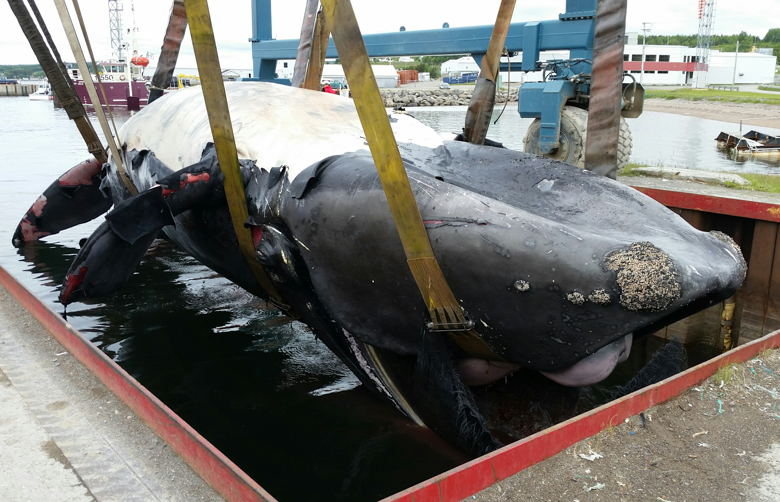
Known as the “urban whale,” the North Atlantic right whale lives primarily in the busy waters along the east coast of the United States and Canada. Major threats to its survival include collisions with ships — the animal’s leading cause of death according to a 2012 study — and entanglement in fishing gear. Another 2012 study of scar patterns on North Atlantic right whales’ bodies found that 83 percent of the animals have been entangled in fishing gear at least once. Whales sometimes manage to shed the gear on their own or with the help of human rescuers, but when they don’t it can exact a slow, excruciating death. Scientists have also documented unexpectedly low calving rates and a dwindling number of females among the right whales, which they have been unable to fully explain.
The causes of the three recent deaths remain unknown.
The first whale was found floating near the small city of Percé, Quebec, on June 24. Scientists towed the carcass to land, hoisted it out of the water, and had it hauled by flat-bed trailer to an inland landfill, where they performed a necropsy, according to Brown. They found no obvious cause of death, although laboratory tissue analyses may yet reveal some clues, she said.
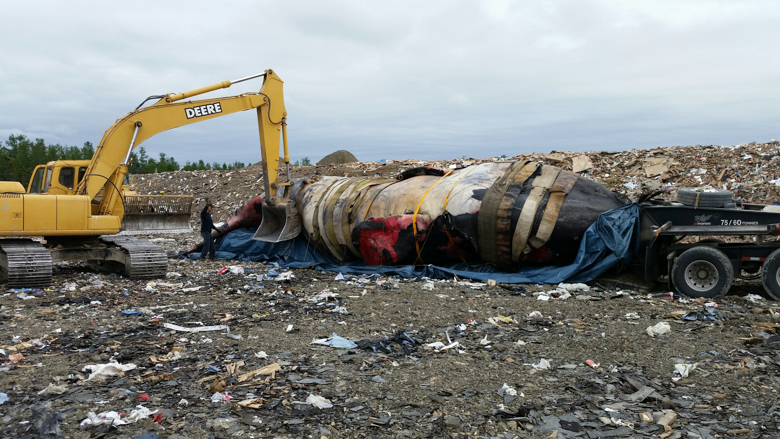
New England Aquarium scientists, who maintain a catalog of nearly every individual member of the species, identified the whale as a roughly 24-year-old female named Piper that they have tracked since 1993. Piper gave birth to three calves over the years, the last one just two years ago. She had become entangled in fishing gear at least twice, in 1994 and 2002, Brown said.
“They didn’t find a fetus, but she would have been due to get pregnant soon, either this year or usually the next year — it’s about every three years,” Brown said. “The tragedy, of course, of losing an adult female, a mom, is that you lose her and you lose her future calves.”
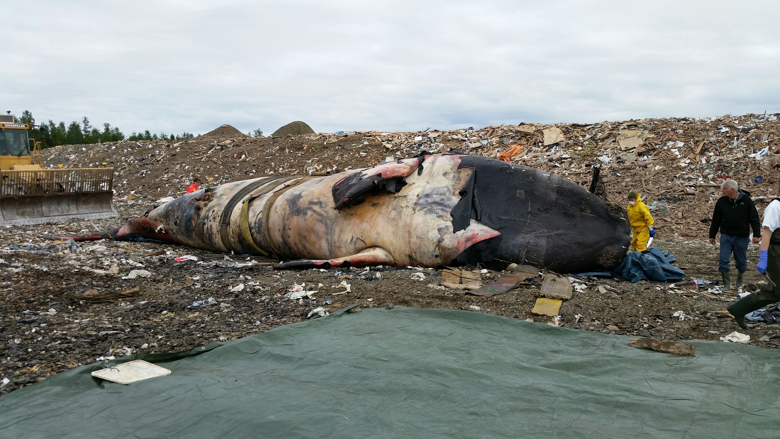
Two weeks after Piper, on July 9, a Canadian government plane photographed a second carcass roughly 70 nautical miles east of Percé. It was floating and already badly decomposed according to Brown. Then, four days later on July 13, sailors photographed a third dead right whale floating about 20 nautical miles west of the Magdalen Islands, also in the Gulf of St. Lawrence.
Neither carcass was relocated. Aquarium researchers could not identify the second body, but the third one they determined to be an unnamed six-year-old female last seen alive on December 27.
Brown called the loss of at least two females “a hit” to the species.
Strange Migrations
The three mysterious deaths come amid a puzzling surge in right whale activity in the Gulf of St. Lawrence, Brown said. Already this summer there have been reports of 20 right whales in the gulf, but the whales usually don’t show up in the area until later in the summer.
“This is an unprecedented number of sightings in the Gulf of St. Lawrence for this time of year,” Brown said.
But anomalous right whale migrations have become the norm in recent years.
A good portion of the population used to dependably migrate between winter calving grounds off Florida and Georgia, winter feeding grounds in Cape Cod Bay, and spring and summer feeding grounds seaward of Cape Cod. And aquarium records going back 35 years show that the majority of whales consistently spent late spring through autumn on two primary feeding grounds well south of the Gulf of St. Lawrence: in the Bay of Fundy and in an area known as Roseway Basin south of Nova Scotia. Among other deviations in the longstanding migration pattern, during the past four summers and falls there have been far fewer whales in those two spots, and the ones that do show up haven’t been sticking around long, Brown said.

The whales seem to be looking for, but not finding, the particular kind of zooplankton—copepods—that they depend upon for food and once found in abundance, she said. She and other researchers suspect that the region’s warming waters are keeping the cold-loving copepods further north.
Brown is gearing up to start the aquarium’s annual boat-based survey for right whales in the Bay of Fundy and Roseway Basin, as it has done every August and September for 35 years. This summer, however, she’ll conduct auxiliary surveys in the Gulf of St. Lawrence, as well.
Finding and protecting whales with new technology
Wherever the missing whales are, they’ve almost certainly gone there in search of food, Brown said, and she and other scientists are determined to find them.
In addition to Brown’s shipboard surveys this summer, the National Oceanic and Atmospheric Administration’s Northeast Fisheries Science Center is conducting regular aerial surveys for the whales in waters off the northeastern U.S.
But right whale biologists are increasingly turning to new technology. The New England Aquarium is part of a collaborative led by researchers at Dalhousie University in Halifax that is attempting to shed light on the whales’ changing migration patterns and find out where they might be congregating.
Last week the group deployed a trio of satellite-linked autonomous vehicles on Roseway Basin and elsewhere off Nova Scotia, Brown said. Two of the vehicles are equipped with hydrophones that can detect and identify four endangered species of whales by their calls: North Atlantic right, sei (Balaenoptera borealis), fin (Balaenoptera physalus), and humpback (Megaptera novaeangliae) whales. The third autonomous vehicle can detect plankton, as well as measure water temperature, salinity, and depth.
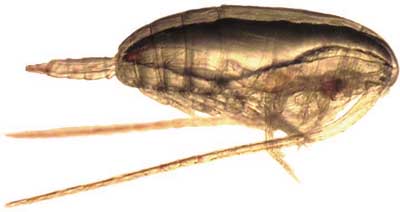
“We’re looking and listening and hoping that we either hear or see something,” Brown said.
It took decades to establish right whales’ critical habitat areas and protect them, including moving certain shipping lanes to avoid them. But now that the whales seem to be shifting their itineraries in response to changing ocean conditions, researchers must rethink how best to protect them. The goal is an agile system for detecting whales wherever they may be and alerting mariners as quickly as possible so they can avoid collisions, Brown said.
In addition to the use of autonomous vehicles, the strategy includes deployment of an app called WhaleAlert that enables anyone to report whale sightings, including of dead or distressed animals. It also warns mariners when whales are nearby and sends them detailed information about reduced-speed and no-go zones.
“We couldn’t have embraced technology at a better time. Because we need help to try and find out where right whales are aggregating. And …the potential area is so vast that we can’t just do it visually alone,” Brown said.
It’s unclear whether any of that could have helped the three North Atlantic right whales dead so far this summer. If there is any silver lining to the untimely deaths it’s that they may eventually offer a clue to the whales’ changing migrations.
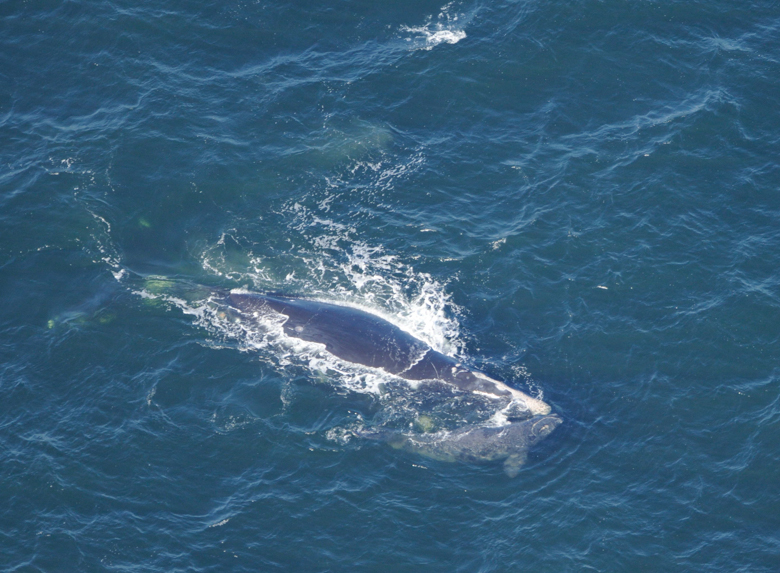
Citations
Van Der Hoop, J. M., Moore, M. J., Barco, S. G., Cole, T. V.N., Daoust, P.-Y., Henry, A. G., McAlpine D. F., McLellan, W. A., Wimmer, T. and Solow, A. R. (2013), Assessment of Management to Mitigate Anthropogenic Effects on Large Whales. Conservation Biology, 27: 121–133. doi: 10.1111/j.1523-1739.2012.01934.x
Knowlton, A., Hamilton, P., Marx, M., Pettis, H., and Kraus, S (2012), Final report on 2009 right whale entanglement scar coding efforts. NOAA, NMFS, Northeast Fisheries Science Center. Contract #EA133F-09-CN-0252.